[Shop for Marker Duke ski binding]
[Other articles about Marker Duke.]
[Ski binding collection index.]
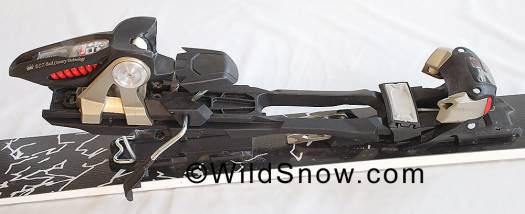
Complete Marker Duke ski binding shown above. Unit is in ski tour mode with climbing lift in up position.
In 2007, If you had been backcountry skiing for thirty years you still wondered why? Or, if you were new to the game you probably still asked the question: Why can’t they just make an alpine binding with a plate/fram and a touring pivot, and be done with it? Why do all randonnee backcountry skiing bindings compromise downhill performance to such a degree?
Then, you wondered no more when Marker released the Duke, their industry leading no-compromise downhill-oriented touring binding. This grabber was still going strong in 2015 and does one thing, does it well: While in alpine mode, Duke is a randonnee touring binding that may even exceed the downhill performance of many full-on alpine bindings.
Duke is a “frame” or “plate” binding that uses a carbon plastic structure to connect the toe and heel units, so the whole machine can hinge on a toe pivot and thus provide a walking (ski touring) function. Difference is that the frame is wider, very rigid, and latches in a firm system of slots with many times the engagement area of past bindings with similar design philosophy (genre known as “frame bindings”).
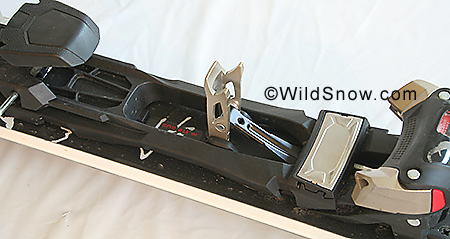
Marker Duke rando binding heel latch.
As shown above, latch in middle of plate is moved up and down to slide the plate for/aft in a system of catches. The binding plate slides back 35 mm when you go to touring mode, resulting in a rearward position while touring unless you slide the plate forward and re-lock the latch while keeping the heel disengaged. We’re not sure locking the plate forward in touring mode is a legit way of operating the binding, but it seems to work. Also, being 35 mm back while touring is usually not a big deal, at times it can make kick turns more difficult, and help at other times. (Note that this binding makes no compromise in ALPINE performance. It does a bit of compromise in touring mode, such as the need to exit the binding to change between latched and unlatched.)
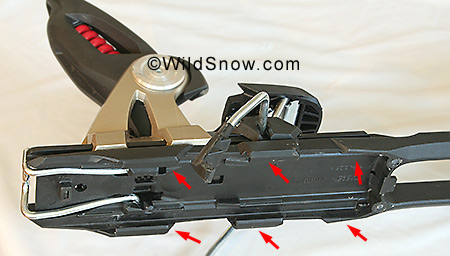
Marker Duke heel unit underside.
These are the catches under the heel that engage with a plate on the ski. Incredibly solid — virtually no play when in alpine mode.
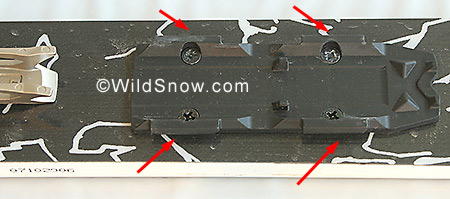
This plate on ski is what engages under the heel. to latch for downhill skiing.
The way this system works (all integrated on one frame/plate) makes Duke easy to home-mount without a template or jig. The toe unit is completely integrated, just place on ski, center, mark holes, drill and screw. Then locate the heel plate by fitting under the binding frame, center with care, mark the screw holes, run those screws in and off you go. See this post for more about mounting, including access to a paper screw pattern template.
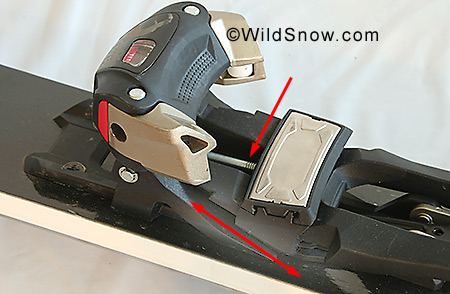
Boot toe height adjustment system, AFD slides up or down on a ramp.
An innovative height adjustment system is one thing that allows Duke to be extra beefy. Most AT bindings with a toe jaw allow for height adjustment by raising and lowering the toe jaw wings with a threaded system. This means the toe can’t be firmly fixed to the ski. To solve that problem, Duke tow jaws are firmly mounted, and height adjustment is done by rotating a threaded rod that raised and lowers the AFD under the boot toe. It moves vertically because it’s slotted into an inclined ramp on botch sides, and slides up and down the ramp.
Note that side (lateral) safety release is done by the toe unit, and is effected by the toe wings moving out to the side, as with most alpine bindings.
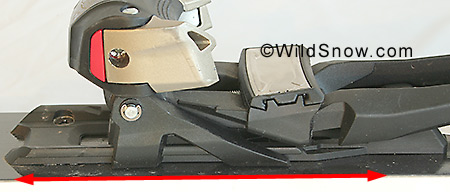
The binding plate slides for and aft by virtue of this track and flange system under the toe.
The track and flange system has potential to wobble, it is manufactured with tight tolerances and has little to no movement. Also note the snap ring on a removable and presumably serviceable pivot axle.
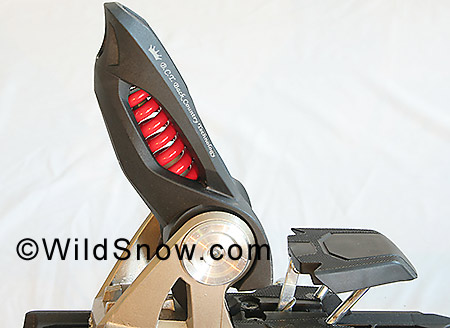
Clear winner of the DIN “mine is bigger than yours” wars, Duke dials to DIN 16, and shows its DIN pride with this red painted spring that is beefy enough to use in my Jeep suspension. Set the binding to DIN 16, and enjoy leaving your foot and ski behind if you take beater. Ouch.
Overall, the Duke is designed with a wider footprint that blends well with today’s wider skis. This stately stance is said to provide more edge control than other bindings. That might be a bit of hype, but after skiing these and bench testing the flex, I can say they’re easily the stiffest AT binding available (meaning laterally, as if pushing the boot cuff from side to side).
Crit? Yes Virginia, you have to exit the binding to change modes, and the heel lifter is difficult to flip while you’re touring. Angle of pivot in touring mode is limited to 90 degrees when the toe unit encounters the ski. This makes the binding vulnerable to damage in a “knee fall” while touring (as when you pitch forward with your knee trying to go down on a ski and thus yank the binding plate violently forward). Also, they’re heavy at 47 ounces per binding, and thus a poor choice if you’re serious about climbing and don’t tend to break bindings.
And what about the name “Duke?” What would John Wayne think? In my opinion this is equipment that redefines macho, so the name doesn’t insult the ultimate man’s man — thus we’re okay there. At least they didn’t, groan, call them “freeride.”
For most of us, Duke is too heavy for ski touring with major vertical (we won’t be trading in our Dynafits), but it looks like the perfect cross-over binding. In other words, this impressive engineering effort could become incredibly popular. At the resort it probably performs as good or better than most alpine bindings — ditto for heli skiing or snowcat skiing — and if you do want to tour you’ve got the machinery to do it. Thus, this could be the ultimate “one-rig” binding for modern resort skiers who make short stabs into the wild.
More, there is a population of backcountry skiers who will make major sacrifices in uphill comfort and energy expenditure to carry beefy gear that holds up for high speed skiing, cliff hucking, film stunts and other shenanigans. For them, Duke could be nirvana. Who knows, such backcountry hucksters might even start watching John Wayne movies. They can start with “True Grit” and work their way up (or down, as the case may be).
In all, finish and function of the Duke binding is exceptional. This is an excellent example of how design, engineering and materials science continue to converge and sometimes improve our lives.
Weight (one binding with screws): 47.1 oz, 1334 gr
Stack height (boot above ski), heel 40 mm, toe 32 mm for positive ramp angle of 8 mm
Shop for Marker Duke ski binding

Marker Duke thumbnail
WildSnow.com publisher emeritus and founder Lou (Louis Dawson) has a 50+ years career in climbing, backcountry skiing and ski mountaineering. He was the first person in history to ski down all 54 Colorado 14,000-foot peaks, has authored numerous books about about backcountry skiing, and has skied from the summit of Denali in Alaska, North America’s highest mountain.
